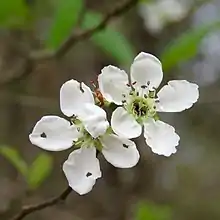Crataegus opaca
Crataegus opaca, known as the western mayhaw, is a shrub or small tree of the southern United States.[1] It is one of several species of hawthorn with fruits known as "mayhaws".
| Crataegus opaca | |
|---|---|
 | |
| Scientific classification | |
| Kingdom: | Plantae |
| Clade: | Tracheophytes |
| Clade: | Angiosperms |
| Clade: | Eudicots |
| Clade: | Rosids |
| Order: | Rosales |
| Family: | Rosaceae |
| Genus: | Crataegus |
| Section: | Crataegus sect. Coccineae |
| Series: | Crataegus ser. Aestivales |
| Species: | C. opaca |
| Binomial name | |
| Crataegus opaca | |
Description
Crataegus opaca can be characterized as either a small tree or large shrub, with typical height ranging from 12–36 feet (3.7–11.0 m).[2] It has a tall and narrow trunk with a rounded crown and spiny branches.[2] It has oval, dark green leaves and when in bloom, clusters of pink or white flowers.[2] Its fruits are relatively large and have a cranberry-red color when ripe.[3] Blooms usually appear between February and March, and the fruit ripens from May to June.[2]
Habitat
This species prefers wet, rich, and acidic soils, and is located in low woods, creeks, and river bottoms, often in standing water.[2][3] Its native distribution ranges from Alabama west to Texas, and north to Arkansas.[2]
Uses
The fruits, known as mayhaws, are commonly used to make jams, preserves, and jellies.[3] While the fruits are bitter raw, the jelly produced from them is highly prized for its flavor.[3]
References
- Phipps, J.B. (2015), "Crataegus opaca Hooker & Arnott, Compan. Bot. Mag. 1: 25. 1835", in L. Brouillet; K. Gandhi; C.L. Howard; H. Jeude; R.W. Kiger; J.B. Phipps; A.C. Pryor; H.H. Schmidt; J.L. Strother; J.L. Zarucchi (eds.), Magnoliophyta: Picramniaceae to Rosaceae, Flora of North America North of Mexico, vol. 9, New York, Oxford: Oxford University Press
- "Lady Bird Johnson Wildflower Center - The University of Texas at Austin". www.wildflower.org. Retrieved 2019-03-06.
- "Wild Harvest: Texas' Bounty of Native Fruits|| TPW magazine|August/September 2013". tpwmagazine.com. Retrieved 2019-03-06.